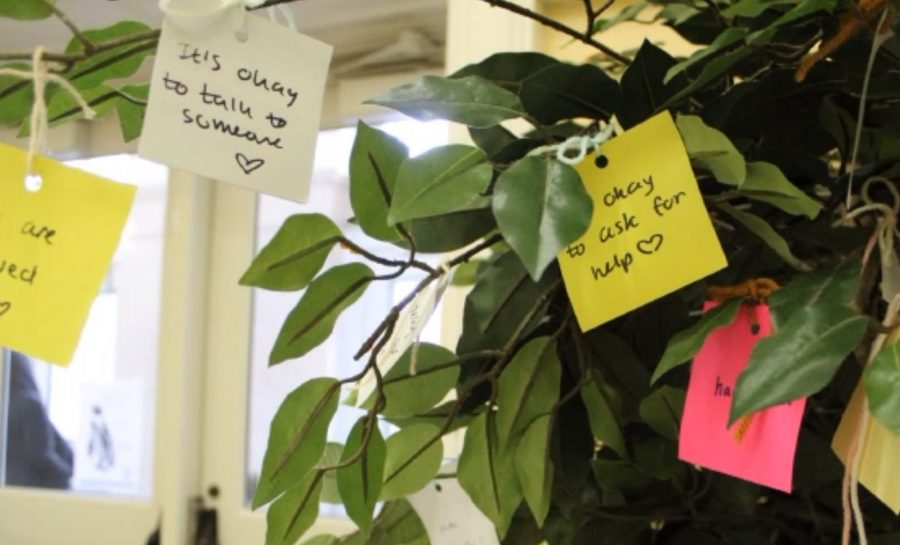The stigma of mental health
and how WHHS students are tackling it
In February, Bring Change to Mind club placed “Positivitrees” around WHHS. Students placed kind notes on them to show support and spread positivity among their classmates.
According to the World Health Organization, mental illness bears the biggest economic cost of any health issue in the world, with estimates of over $2.5 trillion per year, as of 2010. And yet, over 60 percent of people in developed nations, and even more in under-developed, receive no form of care whatsoever. What is the root of this massive gap between diagnosis and treatment? The answer lies in the viewpoint of mental illness still held by much of the Western world.
Despite an increase in total awareness of mental health issues, there still remains a very palpable stigma against mental illness ingrained within Western society. In fact, multiple studies, including one published in the American Sociological Review, shows that the large majority of Americans have some explicit or implicit bias against mental illness, and that can have very real and negative effects on those who are afflicted. That stigma can mean difficulty in the workplace, finding a job or even in social circumstances when looking for friends or a relationship. In addition to the already existing mental struggle, this sort of ostracism can be overwhelming for many who find themselves without support.
Studies published in American Psychiatry show that regardless of education, stigma against mental health permeates through all levels of society, and even appears in professionally trained mental health workers. This perception is fueled by news stories that label attackers as “mentally ill” without any specificity into their condition, promoting the notion of mental illness as a violent affliction.
On top of this, popular depictions of mental illness often trivialize or overly simplify the topic, such as the hit Netflix show 13 Reasons Why, which psychologists contested made depression look as though it had to arise explicitly from other issues, rather than a real mental illness that should work to be treated. Popular media is also guilty of portraying those with mental illness as a result of weak character, a portrayal that can be discouraging to those who may otherwise seek treatment.
This sort of misunderstanding and even vilifying of those who struggle every day with mental illness is devastating to those who now find themselves unwilling to seek out support for fear of being attacked. Combined with the fact that many with untreated mental health issues are more vulnerable to self-deprecation, the idea that 60 percent of those with mental illness don’t seek out treatment becomes clear.
Steps are being taken to counteract this common viewpoint. Experts identify three important tools in removing stigma: protest, education and contact. The protest is refusal to allow news and media outlets to continue their negative portrayal of those with mental illness, and education is actively working to inform those ignorant of how mental illness manifests and what can be done about it. Most impactful, however, is contact: when people meet regular members of the community who happen to suffer from mental illness, it can go to great lengths.

Sammy Stenger, ‘20, participates in a discussion during a meeting of Bring Change 2 Mind. The after school club meets weekly to discuss matters of mental health and ways to support fellow students.
If you would like to be a part of this positive change towards mental health at WHHS, the Bring Change 2 Mind club is one place to start. They meet every Wednesday after school in room 2115. The club grew out of the Youth Council for Suicide Prevention at Cincinnati Children’s Hospital and continues to grow at WHHS.
Meetings consist of education on different types of mental illness, and then working toward a project at WHHS to promote education or awareness of different aspects of mental illness, such as the What Lifts You Up project last December, where members hung cut out paper balloons and allowed students to share what made them grateful in the Arcade. Acts like this are essential for promoting positivity in the school environment, and the club is always looking for new members.
On top of that, if you think a friend is struggling or they’re coming to you with problems, don’t be afraid to refer them to WHHS’ school psychologist Susan Flowers. Her door is always open for emergencies, and if you’re just looking to set up a time to chat or discuss any problems you might be facing, she is more than willing.
If you or someone close to you is considering self-harm in any way, contact the National Suicide Prevention Hotline at 1-800-273-8255
Your donation will support the student journalists of Walnut Hills High School. Your contribution will allow us to purchase equipment, cover our annual website hosting, printing costs and offset competition and conferences fees for students.









